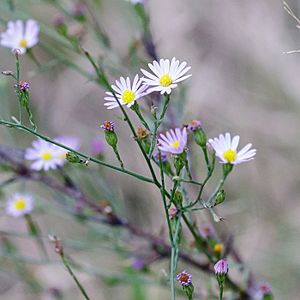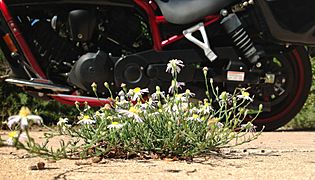Symphyotrichum divaricatum facts for kids
Quick facts for kids Symphyotrichum divaricatum |
|
|---|---|
 |
|
| Bell County, Texas | |
| Conservation status | |
| Scientific classification | |
| Genus: |
Symphyotrichum
|
| Species: |
divaricatum
|
 |
|
| Native distribution | |
Symphyotrichum divaricatum is a type of plant often called the southern annual saltmarsh aster. It's an annual plant, which means it lives for only one growing season. This plant is also herbaceous, meaning it has soft, green stems instead of woody ones. It grows naturally in the southern parts of the United States and some northern areas of Mexico.
What Does It Look Like?
Symphyotrichum divaricatum is an annual herbaceous plant with a main root that grows straight down, called a tap root. It usually grows to be about 60 to 200 centimeters (2 to 6.5 feet) tall. Sometimes, it can be as short as 10 centimeters (4 inches).
Its stems are green and usually grow straight up without many branches. They might have purple or brownish spots. The stems are smooth and hairless, but sometimes tiny hairs can be found where the leaves join the stem. The leaves are thin, smooth, and range from green to dark green.
This plant typically blooms from July to November, but sometimes even into February. Its flowers have beautiful lavender to blue petals, called ray florets. In the center, there are yellow parts called disk florets. After the plant has been pollinated and starts to dry, each ray floret curls up into three to five small coils.
Where Does It Grow?
The southern annual saltmarsh aster is a native plant in several Mexican states. These include Baja California Sur, Chihuahua, Coahuila, and Tamaulipas. It also grows naturally in many US states. You can find it in Alabama, Arkansas, Kansas, Louisiana, Mississippi, Nebraska, New Mexico, Oklahoma, Tennessee, Texas, and Virginia.
This plant has also been introduced to other places. It now grows in Colombia and New York. It likes to grow in wet, marshy areas, along roadsides, in lawns, and in other open, disturbed places. It can be found from sea level up to about 1,500 meters (4,900 feet) high. Sometimes, people consider it a weed because it grows easily in many spots.
About Its Name
The full scientific name for this plant is Symphyotrichum divaricatum (Nutt.) G.L.Nesom. Plants sometimes get new scientific names as scientists learn more about them. As of December 2021, its older name, S. subulatum var. ligulatum (Shinners) S.D.Sundb., is now considered another name for the same species.
How Is It Protected?
As of December 2021, an organization called NatureServe checks on the health of plants and animals. They list Symphyotrichum divaricatum as "Secure (G5)" worldwide. This means it is common and not in danger globally.
However, its status can be different in specific places. For example, in West Virginia, it is listed as "Critically Imperiled (S1)". This means it is very rare and at high risk of disappearing there. In Nebraska, it is "Apparently Secure (S4)", meaning it is fairly common. It is also found in Missouri, but it is not native there. NatureServe last checked the global status of this plant on December 21, 2001.
See also
 In Spanish: Symphyotrichum divaricatum para niños
In Spanish: Symphyotrichum divaricatum para niños




